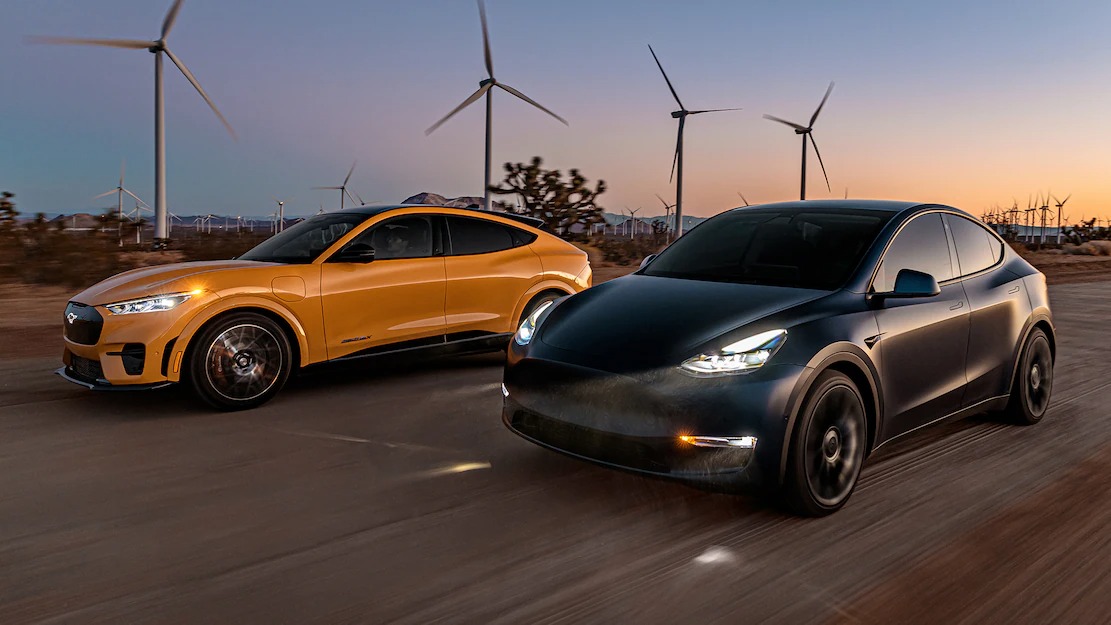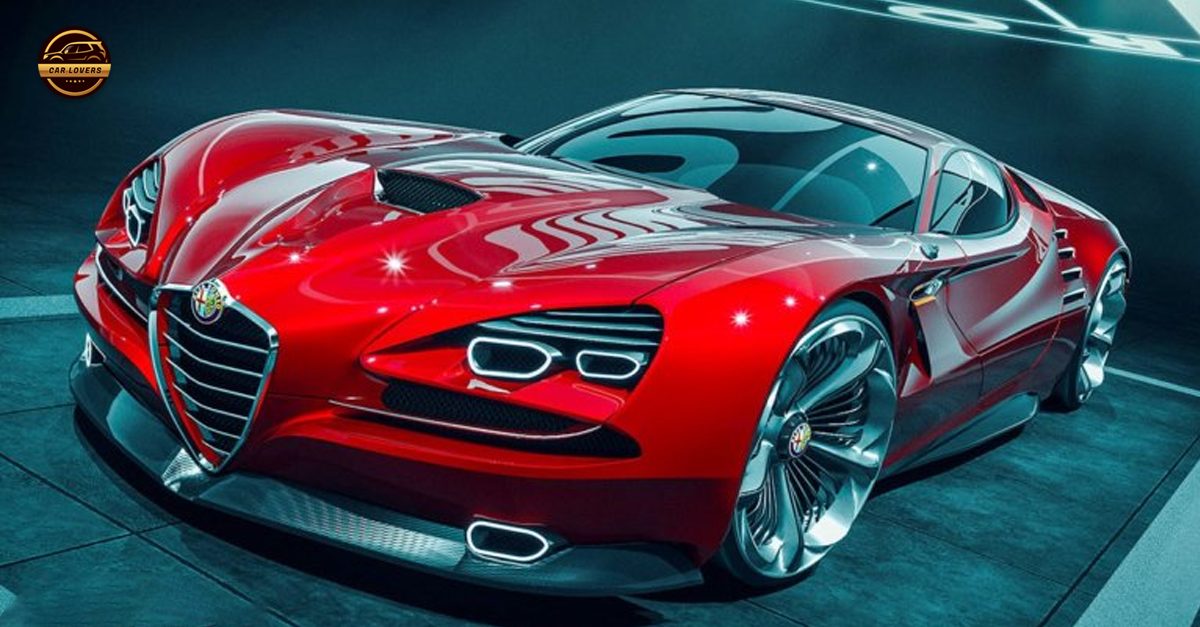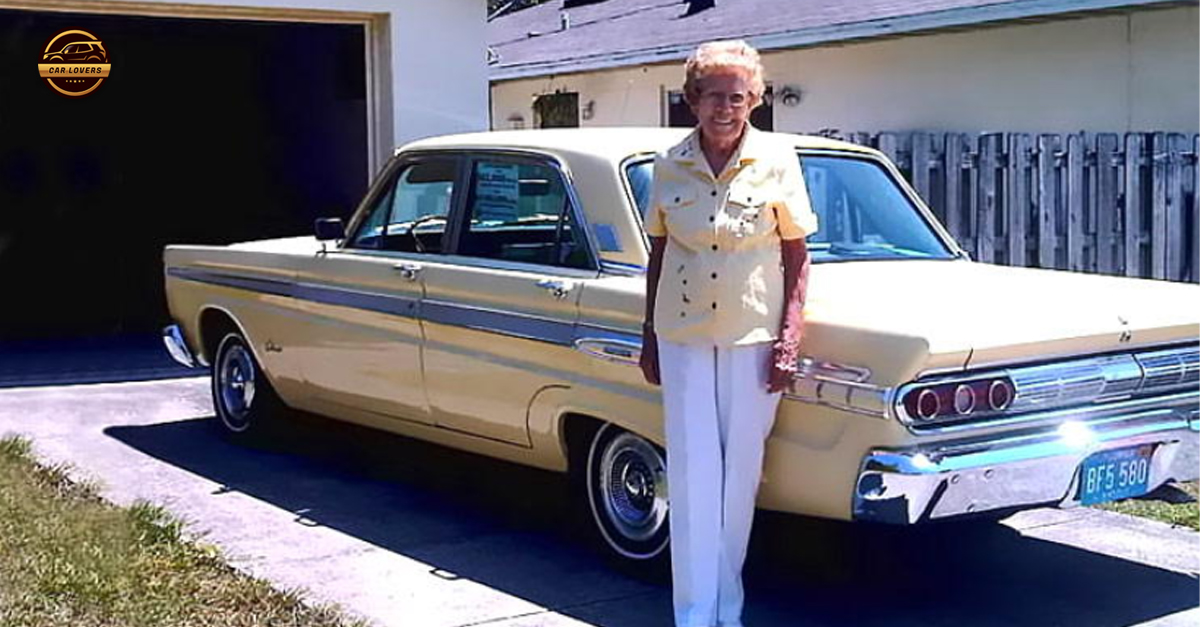With Tesla and Ford dropping prices on their EVs, which of these electric crossovers comes out on top?
Whether it’s the expansion of EV tax credits or that supply chain issues are getting better, both Tesla and Ford have recently announced they lowered prices on their two popular, all-electric crossovers—the Tesla Model Y and the Ford Mustang Mach-E. Which begs the question: When comparably equipped, which electric crossover offers buyers more?

To make this as fair as possible, we’re going to try and match equipment and range of both the Model Y and the Mach-E. The challenge is that Ford offers two drivetrain options and four trim levels, with plenty of chances to mix and match. The Model Y only has two trims, and both are all-wheel-drive. Another difference is that the Model Y can come as a seven-seater with a two-person third row seat. The Mach-E only allows for five.
We’re also opting to not compare Tesla’s Autopilot or Full Self-Driving system to Ford’s Blue Cruise. Given all that, let’s narrow this look to the Mustang Mach-E Premium eAWD with its extended range battery against the Model Y Long Range, as well as the Mustang Mach-E GT eAWD against the Model Y Performance.
Mach-E Premium EAWD Extended Range Or Model Y Long Range?
In our most recent comparison between the Mach-E Premium eAWD Extended Range and the Model Y Long Range, the Model Y took the edge as a better all-rounder. Each had their strong points. The Mach-E has a much more comfortable ride, particularly over rough pavement. But the Model Y offers more granular driving mode settings, allowing individual drivers to find their personal sweet spot a little easier than in the Ford.
The Model Y is billed as a luxury-level midsized crossover, but its spartan interior is starting to feel a bit underwhelming even when compared to the Mach-E’s. The Ford’s interior feels warmer than the Tesla’s while also borrowing ideas such as hidden air vents and a large central screen. “The cabin offers a clean, fresh-feeling execution for a Ford,” we said, adding that the handsome gray cloth on the dash and speakers brought a premium feel.
However, when it comes to passenger and cargo room, the Model Y ends up on top while the Mach-E’s sporty exterior hampers its interior space. “Cargo space is ridiculously impressive, with a deep (3.1-cubic-foot) hidden area under the floor,” we said. “The seats fold flat, too, and you feel like you could camp in the car.” Rear passengers also have more foot- and legroom in the Model Y—the Tesla’s front seats are situated on risers in part to provide more toe space to rear riders.

It’s the same story on the technology front, with the Model Y offering a more intuitive interface despite being limited to a single, centrally mounted screen. Ford’s system requires more digging in menus and a slower response time to inputs—at least it did before the latest OTA update from Ford, which we haven’t yet been able to test in a Mach-E. The update brought a number of changes, including utilizing the central knob to adjust HVAC controls and other functions beyond audio volume, adjustments to the home screen for new icons and status bar, and changes to SYNC 4A to make finding settings and controls easier.
When it comes to overall efficiency and range, the Tesla Model Y offers another big advantage. Despite a larger 91-kWh battery pack, the Mach-E eAWD will only manage 290 miles before needing a fill-up. The Model Y, on the other hand, is capable of going another 40 miles despite a smaller 75-kWh pack. Even on its optional 20-inch wheels, the Tesla can exceed the Mach-E’s range by 28 miles. Then there’s the not-insignificant advantage of Tesla’s excellent Supercharger fast-charging network, which is capable of delivering 250 kW or about 12 miles per minute of charge to the Model Y. The Mach-E Premium is only capable of a 150 kW charge, or about 5 miles per minute of charge on a DC fast charger.
The one major setback for Tesla is its notorious build quality issues, including but not limited to large panel gaps, frustrating Service Center experiences, and steering wheels that just fall off while driving down the highway. Ford has a better track record with fitment and safety, although it’s not immune to issues. And Ford has a large and well-established dealer network to get the Mach-E serviced when it does need something.
Despite a few issues, the Tesla Model Y has numerous advantages: a better charging network, better technology, and more utility. Given that, when similarly equipped, the Tesla Model Y Long Range is just $54,380 with the recent price drop, it makes the $62,495 of the Ford Mach-E Premium eAWD seem extra pricey. If you’re only concerned with daily driving and ease of servicing, the Mach-E might be the better option. For everyone else, the extra range and the availability and consistent functionality of the Tesla Supercharger network make the Model Y the better value here.

Mach-E GT Vs. Model Y Performance
Ford and Tesla also sell higher-performance options for the thrill-seeker: the Mach-E GT and the Model Y Performance. It’s not a secret that both vehicles are probably faster than they have any need to be, but we’re glad they exist.
On paper, the GT outmuscles the Performance, with 480 hp and 600 lb-ft of torque. The Model Y Performance makes do with 456 hp and 497 lb-ft—even so, these are numbers most internal-combustion crossovers would dream about. And the Model Y makes up for its lack of grunt with a slightly quicker time to 60 mph (3.5 seconds for the Tesla, 3.6 seconds for the Mach-E). Get out to the quarter mile and the Model Y starts to gap the Ford it as it crosses the trap with a 12.0 second ET and 114.7 mph speed, with the Mach-E GT trailing behind by 0.6 second behind at 100.6 mph.
The Mach-E GT makes up some ground in the comparison when the road get twisty. The Ford is extremely well balanced, but occasionally it lacks the predictability we prefer in something we’re going to drive hard. That said, the Ford is more settled and composed, with better control of its wheel and body motions. The Tesla is by no means unrefined or a poor handler—quite the opposite—it’s just that the Ford is slightly ahead in these areas.
Get on the brakes, the Mach-E also performs better, if only just. From 60 mph, the Mach-E GT uses only 105 feet while the Model Y Performance needs 113 feet. Those numbers might be close, but in real life they can make a big difference. During our road loop, the Ford felt like it had more grip and allowed us to brake later when approaching a corner. Despite that, our testers liked the Model Y more at the end of the day. It was its stronger, relentless acceleration, as well as the Tesla’s consistency and predictability in its handling characteristics that made it our choice. We’d never turn down more miles in a Mach-E GT, however, and further fine-tuning of its software and chassis hardware ought to make it truly special in the future.

Of course, with all of that performance, the downside is that range is also decreased (just like it would be for an ICE-powered crossover). The Mach-E GT will get you about 270 miles on a single charge while its highest performing version, the GT Performance Package with its extra 34 lb-ft of torque, drops it to 260 miles. The Model Y Performance, on the other hand, benefits from the extra range that the standard Y finds over the regular Mach-E. It’s able to go 303 miles while rolling on 21-inch wheels (the Mach-E GT/GT Performance uses 20-inch wheels). Both also use the same charging systems as their less performance counterparts we compared above, and come with the same advantages and disadvantages listed there.

When you want the best performance out of your all-electric crossover but also the best value, which do you go for? Just like the less-performing versions of the Mach-E and the Model Y, the Ford comes across as not offering enough performance to make up for its increased cost. At $65,495, the Mach-E GT eAWD is $7,115 more than its Tesla Model Y Performance counterpart, and it’s marginally slower to 60 mph and offers less range. That’s even before adding on another $6,000 for the GT Performance Package, which adds 15.2-inch front rotors, summer tires, and MagneRide dampers along with the 34 lb-ft of torque boost. That makes the Mach-E GT Performance an astonishing $13,115 more than the Model Y Performance, the crossover our editors would rather be driving.
We have to say the new price of the Model Y Performance makes it the better value in electric performance crossovers. Once you add in the addition of the Tesla Supercharger network and its 250 kW charging rate, it’s not much of a contest—you’re going to get more for your money with the Tesla Model Y Performance.





